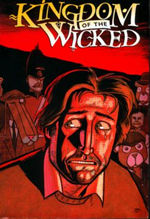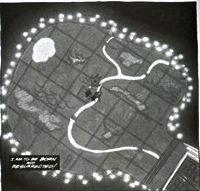>> The Friday Review: The Birthday Riots
>> The Friday Review: A Distant Soil: The Gathering
More...

 Writer: Ian Edginton
Writer: Ian Edginton
Artist: D'Israeli
Price: $12.95/£9.99
Publisher: Caliber
ISBN: 0-041613-97-6
Most stories, at their heart, are about conflict; two opposed forces, each pulling in opposite directions until either one breaks free. What these forces are differs wildly, ranging from two people fighting over their attraction for one another, to the all too familiar A-to-B plot path of most cop movies.
KINGDOM incorporates the standard "story as conflict" into it's structure, but takes it to it's logical extreme. Here, there's nothing but conflicts, all nested within one another, and each embodying the central themes of the book.
The story focuses on Chris Grahame, an author whose success has taken him as much by surprise as anyone else. A children's author, Grahame began writing as a child, populating his imagination with the land of Castrovalva and it's vast and varied inhabitants. Years later, Castrovalva has become less his childhood refuge, and more the key to his success.
Indeed, at first glance, Chris Grahame has everything; a successful career and a fantastic home life. However, the first conflicts come to light almost immediately. Grahame is uneasy about his success, both due to his fear of being a "one hit wonder" and also, subconsciously, because of the nature of his work.
His stories, written first for himself as a child and later for his own daughter, are an intensely personal thing for him, and it becomes clear as KINGDOM progresses that he feels both uneasy and almost guilty that he's exposed them to public view. The inner workings of his own life are on the page for all to see, and he's honestly not sure whether they should be.
This first conflict provides the framework for everything that follows, and makes the book an altogether more personal experience than it would normally be. Grahame is a deftly realised, very human protagonist, a man whose dry, calm humour masks a genuine fear of what he's becoming and whether he's making the right choices. The most unconventional of 'heroes', he's also the heart and brain of the story, and all the more sympathetic for that.
 This becomes all the more apparent as the second major conflict in the book makes its appearance. Over time, Grahame is drawn back to Castrovalva, only to find it very different from the place he imagined in his childhood. Here, a war is being fought against 'the Great Dictator', but the Great Dictator is winning, and only Chris is capable of understanding why.
This becomes all the more apparent as the second major conflict in the book makes its appearance. Over time, Grahame is drawn back to Castrovalva, only to find it very different from the place he imagined in his childhood. Here, a war is being fought against 'the Great Dictator', but the Great Dictator is winning, and only Chris is capable of understanding why.
The Castrovalva sequences are where KINGDOM really comes into it's own. D'Israeli's scratchy, almost caricatured style is allowed to run riot in a world where two very clear mindsets are at war with one another. Indeed, it's through his artwork, especially in the trench warfare sequence, that the true nature of the book's central conflict reveals itself. Put simply, this is a book concerned with childhood, the innocence we lose when we move into adulthood, and what happens when that innocence refuses to go quietly.
As the book progresses, it emerges that not only the Great Dictator, but Grahame himself have influenced and warped Castrovalva. At its heart, Castrovalva is still a childhood fantasy, but the child that created it is long gone. Thus Grahames' adult perceptions become almost as perilous to the land as the Great Dictator himself, as demonstrated by the war and Grahame's differing experiences of it.
Straight away, D'Israeli's art makes it clear that things aren't right. In short order, we're shown nursery rhyme cavalrymen being struck down by tanks, running gun battles through the streets of Castrovalva, and a tired, embittered regiment of teddy bears. On paper, this sounds absurd and more than a little funny. However, as portrayed by Edginton and D'Israeli, this pivotal sequence becomes truly horrifying.
Here, we see the central conflict of the book bleed over into Castrovalva and change it forever. The Chumblies, the race of teddy bears on the frontline, were among Grahame's closest friends during his childhood, and remain as they once were; short, fat and endearing.
However, their presence on the frontline shows how times have changed, and while their bodies are the product of a child's imagination, what they say is undoubtedly the product of a man's. These are soldiers who are tired, desperate and abandoned, left to fight on a front line no-one cares about in a war that was inflicted on them. Here, childhood and adulthood clash together time and again, and the Chumblies are the first casualties.
 The overall effect is deeply unsettling, as the reader sees these childhood toys seemingly trapped within a World War I story. However, it's made more acute as the sequence progresses, and we learn that the human officers who initially drove the Great Dictator out have retired to safely behind their lines. In short, not only is there war in Castrovalva, but discrimination as well. The Chumblies have been left to hold the line not because they're best suited for it, but because the human soldiers simply do not want to.
The overall effect is deeply unsettling, as the reader sees these childhood toys seemingly trapped within a World War I story. However, it's made more acute as the sequence progresses, and we learn that the human officers who initially drove the Great Dictator out have retired to safely behind their lines. In short, not only is there war in Castrovalva, but discrimination as well. The Chumblies have been left to hold the line not because they're best suited for it, but because the human soldiers simply do not want to.
Here then, is the ideological heart of both the book and every other conflict within it. Chris Grahames' crisis of faith sees him retreat to a childhood refuge that is also the perceived seat of his talents. However, his very presence there as an adult, combined with the experiences and sensibilities he brings with him, begins to change the place. Ultimately, Grahame must reconcile the child he was with the man he is, and it's this journey that powers much of the book's second half.
This is an unusually subtle, complex story and it's helped immeasurably by D'Israeli's art. The standout moment comes toward the end of the book, when Grahame makes his way into the Great Dictator's camp, located in the Forest Under the Bed. The almost full-page rendering of this perfectly evokes the queasy, off-kilter feeling of the war torn Castrovalva, with Grahame framed against an immense, rocky bed and the path he's on vanishing beneath it.
The imagery is pure fairy tale, but, like the best fairytales, it's also deeply unsettling. The trench warfare sequence with the Chumblies is notable for the same reason, juxtaposing the endearing appearance of the bears with their desperate, savage anger at their situation.
Throughout KINGDOM, D'Israeli's art acts as a mirror to the tone of the script, changing as the script requires. The climax, where we discover the true nature of both Castrovalva and of Chris Grahames' circumstances, are a perfect example of this, the crisp line work of the previous pages being supplemented by a lush, detailed quality similar to painted work.
KINGDOM OF THE WICKED is a subtle, multi-layered look at both the nature of stories and the process of growing up. Edgintons' script is both horrific and humane, its central themes reflected in every aspect of the script and art. Combined with D'Israeli's eccentric, hugely effective artwork, it stands out as a story about childhood, adulthood and the loss of innocence that occurs between. Combining horror with a genuinely human touch, KINGDOM is by turns a story about the process of writing, the pain of growing up and, most importantly, about redemption. And, like the best fairy-tales, it's all as true as you want it to be.

This article is Ideological Freeware. The author grants permission for its reproduction and redistribution by private individuals on condition that the author and source of the article are clearly shown, no charge is made, and the whole article is reproduced intact, including this notice.


